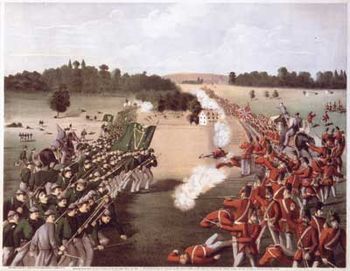Fenian Uprising–Malone: Part 3
 |
| Fenian raids (Photo credit: Wikipedia) |
The Fenians arrived in Malone expecting to find arms awaiting them. Wrong. The US government had confiscated most of them along the border. Thus, unarmed, the Fenians thought it best to not attack Canada in 1866.
Border agents seized a trainload of arms in Watertown. The Fenians recaptured them. Once more, in DeKalb, all the arms were confiscatedm and the Fenians were unable to get them back.
General Meade approached Malone with one-thousand regulars. On June 3, 1866, he ordered the Fenians to disband. Many desertions followed and all who applied for transportation home were given it. Thus, Malone became a peaceful village once more.
Over twenty-thousand prisoners were captured in Canada and sentenced to be hung. Most were commuted to life imprisonment.
For four years, not much happened as far as the Fenian revolution. In the early spring of 1870, a second movement began. This time, they forwarded their arms months ahead of time. These supplies were hidden in the barns of sympathetic farmers. Chateuagay, Fort Covington and Hoagansburg were principle hiding places. Arms were then hauled to Trout River.
Malone was chosen as a principle invasion point. They would rush a troop into Canada. There they would wait for reinforcements. The troops who assembled in Malone did not camp here as they had in 1866. Instead they hurried off to Trout River
On May 25, 1870, they marched into Canada from the farm of George Lahey, a half mile south form Trout River. The Canadians were warned by spies, but no Canadian troop reached Huntingdon until May 26, so the place was undefended.
The Fenians advanced about three miles, and staked out a position on the Donnelly farm. Here they levied the farmers for food, raided stores and, in general, acting like invading armies.
Because their reinforcements failed to come. The Fenians retreated back to Leahy’s farm on May. 26.
Next week: the conclusion of the Fenians in Malone. Do any of you have information regarding these raids you’d like to share?
All work for this article taken from:
Seaver, Fredrick. Historical Sketches of Franklin County. Albany: JP Lyons, 1918.

No Comments